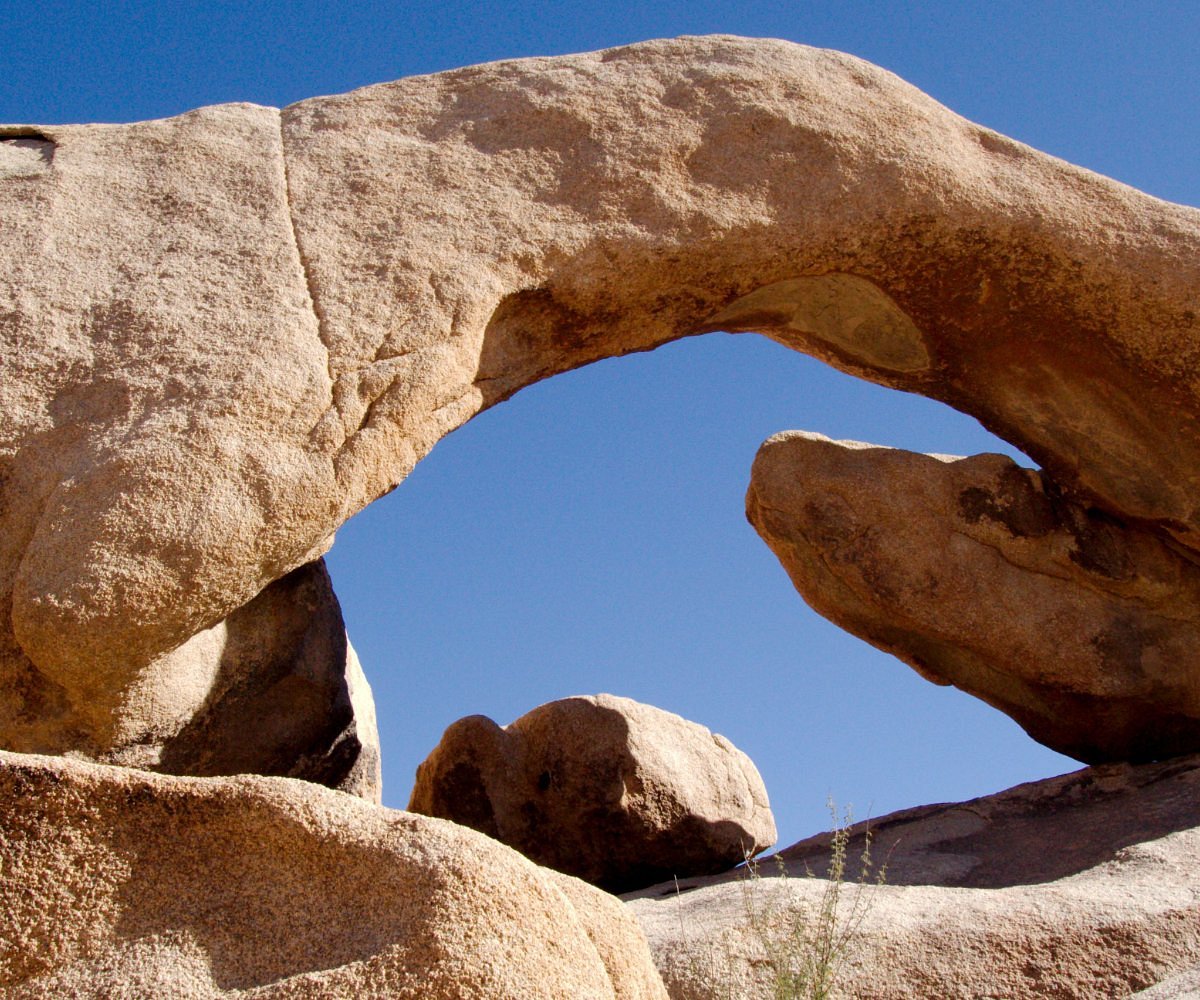A Perfect Itinerary for Adventure Seekers
Spending one day in Joshua Tree National Park is an unforgettable experience. In March 2024, I finally visited this incredible place, and it truly exceeded my expectations. After researching, mapping, and refining my itinerary, I made sure to maximise my time exploring this breathtaking desert landscape. With my expertise in crafting efficient travel plans, I’ll help you discover the best things to visit, from cannot-be-missed spots like Cholla Cactus Garden, Arch Rock, and Skull Rock, to scenic viewpoints perfect for sunrise and sunset.
Starting early is key to experiencing the best of Joshua Tree National Park without the hassle of crowds. My first stop was Cholla Cactus Garden, where the golden morning light illuminated the vast field of cacti. I even saw Samantha, a fellow traveler, walking the trail in black, completely mesmerized by the scenery. Moving forward, I explored Hidden Valley, an area surrounded by dramatic rock formations, making it a paradise for hikers and climbers.
Beyond the natural wonders, the park offers more than just scenic beauty. There are quirky and wild west attractions nearby, including Pioneertown, a historic town that feels like stepping into an old Western movie. If you’re into history, you might find it fascinating—almost like seeing Rome as it was 2000 years ago, brought to life in a multimedia show.
If you’re spending just one day here, a well-planned trip ensures you see as much as possible. The sense of adventure is heightened when you know exactly where to go. Since I traveled from Palm Springs, my start and end locations made the itinerary flow smoothly. With so many activities included, I felt like I got the most out of my visit.
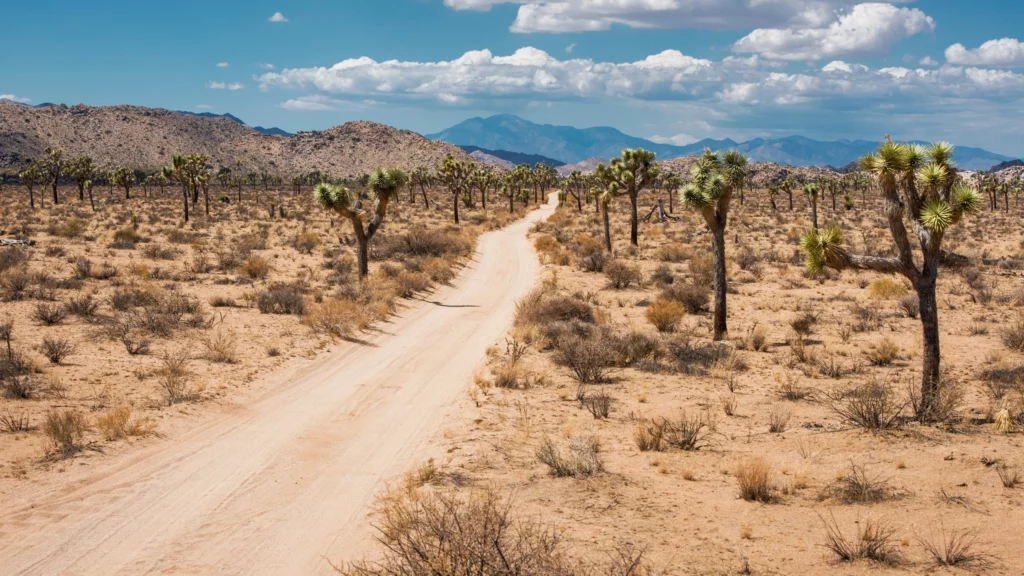
if you are looking for the top hostels in Central america checkout our detailed blog post here.
Kicking Off the Year with an Epic Journey
Welcome to Flying Dawn Marie, my personal travel space where I share the best itineraries with my friends. For my first adventure of 2025, I’m kicking off January with an unforgettable day in Joshua Tree National Park. Having spent the last five years exploring, I’ve uncovered the park’s most breathtaking stops. Whether you’re visiting with family or solo, there’s something for everyone.
The iconic Joshua trees, sweeping vista views, and hidden slot canyons make this place a dream for outdoor lovers. The best part? You don’t need multiple days to enjoy it all. I followed a 2-3 day travel guide before, but if you only have a single day, this condensed plan covers all the essentials. I even marked out the best locations on Google and Apple maps, so you won’t waste any time getting lost.
If you’re a night sky enthusiast, don’t miss the stargazing spots. The desert wilderness provides some of the clearest night skies in the country, making it a perfect place to unwind after a day of adventure. I also made sure to include dining recommendations for those looking for a good meal after a long day of hiking.
Making the Most of Your One-Day Adventure
If you’re hoping to spend a full day in Joshua Tree National Park, you might be wondering how to plan it efficiently. Don’t worry—I’ve got you covered! My itinerary is guaranteed to take you to the top sights and help you see as much as possible in just one day. Plus, I’ll share the best tips on where to stay, when to go, and more.
This giant outdoor playground is filled with rock piles, boulders, and rugged trails. It’s truly a mecca for hikers, climbers, and explorers. You might wonder, “How much time do I actually need in Joshua Tree?” The answer is simple—one day is absolutely enough! Despite its size of 800,000 acres, you can definitely explore the park’s highlights in a short time.
The best part? The park’s close proximity to major cities like Los Angeles, San Diego, and Las Vegas makes it an easy day trip. Whether you’re coming from Las Vegas or San Diego, you can start early and make it back by nightfall. Learn how to make the most of your trip by sharing this itinerary with fellow travelers.
This perfect itinerary takes you to must-see attractions, from unique rock formations and beautiful hikes to hidden gems that most people miss. If you’re looking for the most efficient way to experience Joshua Tree, this is it. Just make sure you’re ready to pack your bags, hit the road, and enjoy every moment!

Where is Joshua Tree National Park?
Joshua Tree National Park is located in southern California, making it an ideally positioned destination for a day trip. It is just 3.5 hours away from four major cities—San Diego, Los Angeles, Las Vegas, and Phoenix—which makes it a great option for travelers visiting these cities. Many people visit Joshua Tree for one day as part of a larger road trip through the area, often combining it with other popular places like Death Valley or the Anza Borrego Desert.
if you want to spend 3 day in maui checkout our maui 3 days itinerary.
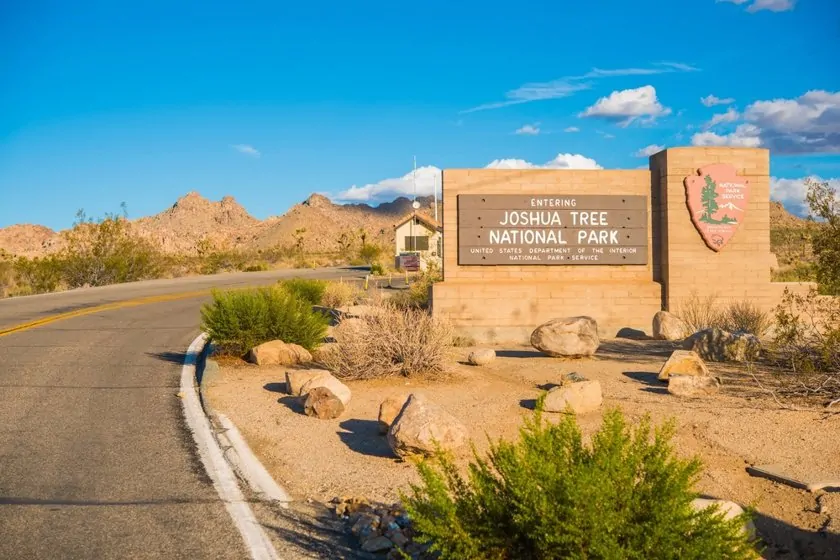
How to Get Around Joshua Tree National Park
Joshua Tree National Park has five different entrances, but not all are useful for a one-day itinerary. While two short roads lead to dead-end areas with a limited number of hikes and activities, most visitors enter through the West Entrance Station on Route 62. This entrance is the best starting point as it leads to Park Boulevard, a scenic drive that cuts through the heart of the park. Along this road, you’ll find some of the top sights, making it the best option if you’re focusing on key attractions.
After driving about 25 miles, you’ll reach a decision point. You can either continue along Park Boulevard and exit at the North Entrance Station, which will bring you back to Route 62, or alternatively, you can turn onto Pinto Basin Road. This route is less traveled and takes you to the quieter, equally scenic southern portion of the park. While there isn’t much hiking here, it is ideal for sightseeing. The drive shows a fascinating transition from the Mojave Desert, with its piles of jumbo volcanic boulders and prickly Joshua Trees, to the Colorado Desert, home to Ocotillos, Cholla Cacti, and flat desert washes. If you take this road, you’ll end up at the Cottonwood Entrance and exit onto Route 10.
How long does it take to drive through Joshua Tree National Park?
Driving from the West Entrance to the North Entrance of Joshua Tree is a scenic drive covering 35 miles and takes about an hour without stops. However, with so many best places to see along the route, you’ll definitely be making lots of stops. If you take the longer route from the West Entrance to Cottonwood, the scenic drive extends to 60 miles and takes around 90 minutes without stopping. But for a one-day Joshua Tree itinerary, you won’t be simply driving straight through—you should plan to spend the full day enjoying all the park’s highlights.
Which way should I drive through Joshua Tree?
The best scenic drive through Joshua Tree is to start at the West Entrance and exit at the North Entrance. Many of the park’s top attractions are found along Park Boulevard, so starting at either end and completing this one-way journey is the perfect way to see the highlights, especially if you have only one day. In this Joshua Tree itinerary, you should take Park Boulevard with a short detour onto Pinto Basin Road to make sure you experience all the best places in just one day.
How to Visit Joshua Tree National Park in One Day?
Visiting Joshua Tree National Park for a one-day visit requires careful planning to ensure you see the best spots. If you’re driving from Los Angeles,
Start Early
it’s important to start early. The drive is long, but arriving early helps you squeeze in more locations from your itinerary and avoid the crowds. By 10:00 AM, parking lots are often full, and in summer, the heat in the middle of the day can be unbearable.
The best way to begin your adventure is at Cholla Cactus Garden during sunrise. Watching the golden light over the mountains in the distance is a magical experience. This stop is perfect for photos and a quiet start before the park gets busy.
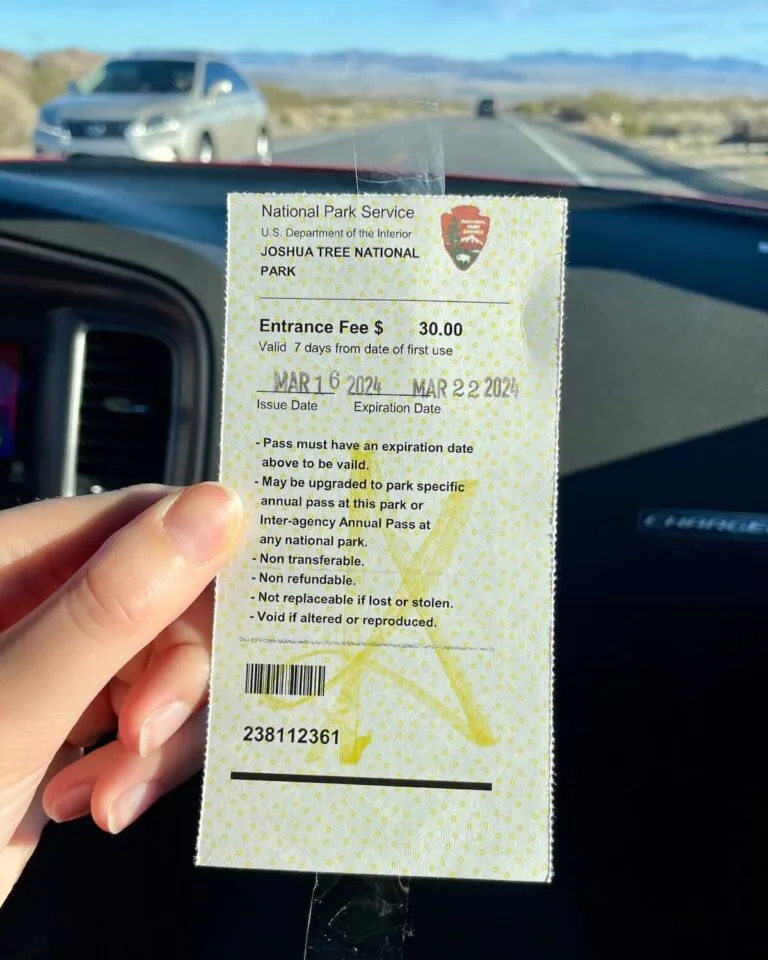
Getting a Park Permit
To enter Joshua Tree National Park, you need a permit. The admission fee is $30 per car, and you can purchase a ticket at the entrance station. If you arrive before 7:00 AM, there won’t be any staff to assist you, so you must pay on your way out. If you arrive after 9:00 AM, expect a long line, especially at the west entrance. A better option is to stop by the visitor centre on Park Boulevard to buy your pass before heading to the entrance.
If you own a National Parks pass, you won’t need to buy an additional entrance ticket.
Food and Drink for the Day
Bringing snacks and plenty of food and drink is key to making the most of your 1-day adventure. There are no restaurants inside Joshua Tree National Park, so packing a meal will help maximise your time. There are picnic tables available for a quick meal, making it easy to enjoy lunch while exploring.
Water is also essential. There are no refill stations inside the park except at the West Entrance Station, so bringing at least two bottles of water per person is necessary. If you want to have lunch outside the park, La Copine is a great restaurant nearby, but only if you’re willing to take a short detour from the visitor centre. For dinner, I highly recommend stopping by Pioneertown.
Driving the Best Route
There are several entrances to access Joshua Tree National Park, but the best way to drive through the park is in a loop. The most efficient route, both logistically and for avoiding long queues, is to enter through the North Entrance Station in Twentynine Palms and exit from the West Entrance Station in Joshua Tree.
This direction is ideal because the North Entrance tends to be quieter, with a smaller queue, while the West Entrance aligns well with a logical sightseeing order. This plan makes sense to cover all major spots without backtracking.
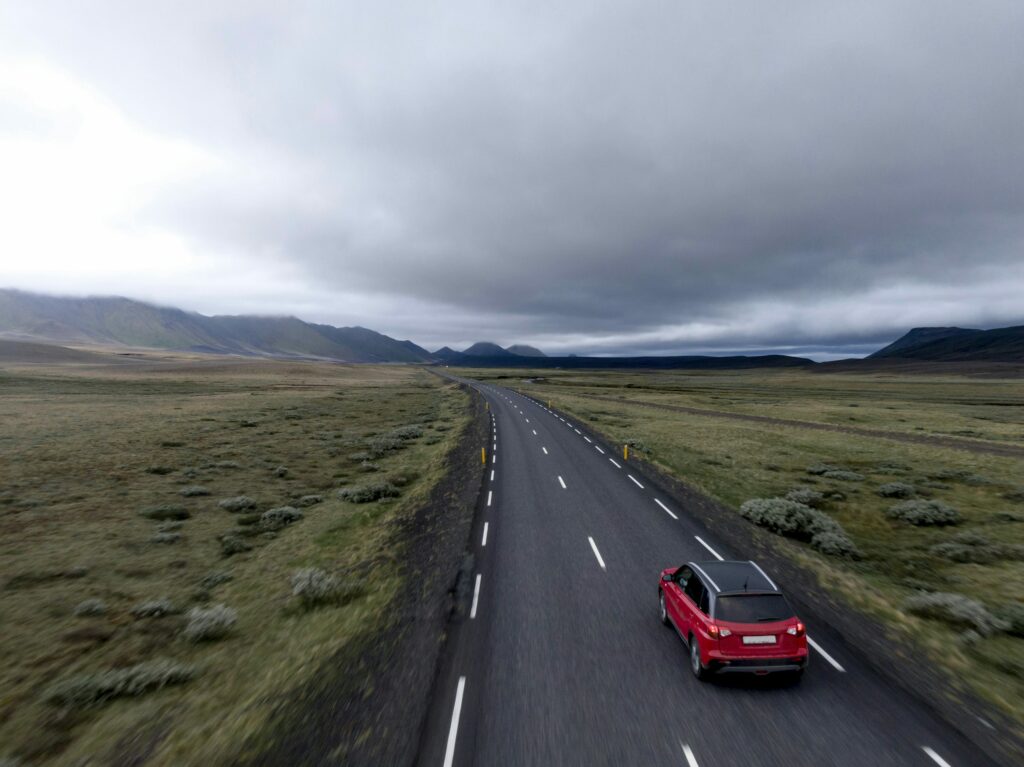
Access to a Car
Having a car is crucial for exploring Joshua Tree National Park efficiently. If you don’t have your own vehicle, you will need to rent one. However, avoid renting an e-vehicle, as there are no charging points inside the park or in nearby towns.
It’s best to rent a car from an airport, as local rental shops may have limited availability. When I tried renting from Anaheim, there were no suitable cars available despite my pre-ordered reservation. I had better luck at LAX airport, where more options were available.
Must-See Locations
There are many incredible places in Joshua Tree National Park, but some are absolute must-sees. If you’re wondering what to see, don’t skip these essential stops:
Cholla Cactus Garden
Arch Rock
Skull Rock & Jumbo Rocks
Hidden Valley Nature Trail
These locations offer stunning rock formations, scenic viewpoints, and unique desert landscapes, making them perfect for a one-day visit.
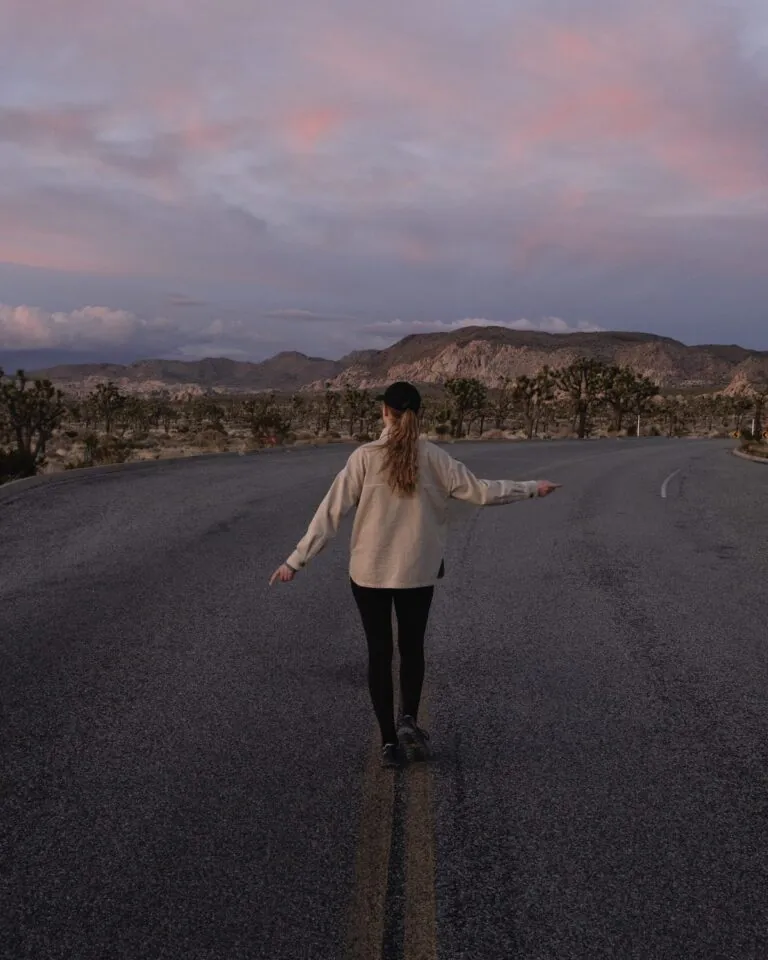
Enjoying Sunrise and Sunset
One of the best things about Joshua Tree National Park is the stunning sunrise and sunset views. If you’re starting your trip from Palm Springs, you’ll have a better chance of catching the sunrise, especially between October and March, when daylight is shorter.
Sunset is easier to catch, even if you’re only in the park for 1 day. Staying until golden hour will reward you with breathtaking colors, perfect for photography. I took some of my favorite photographs of Samantha, who was walking along the road under a pink sky, wearing a beige jacket. The lighting during this time makes every shot look spectacular and well worth the effort of staying late.
Exploring Nearby Attractions
After a full day of adventure, you can check out nearby attractions before heading back. One of the best stops is Pioneertown, which is on the way back to Palm Springs or LA.
In the evening, Pioneertown becomes a lively spot with musical performances at Pappy & Harriet’s and the Red Dog Saloon. Seeing the restaurant sign at Pappy + Harriet’s Pioneertown Palace, with motorcycles parked in front, gave me an old Western town vibe. It was the perfect way to end my trip before heading home.
Read: how to spend 1 day in paris
One Day Joshua Tree Itinerary
Visiting Joshua Tree National Park for one day is an unforgettable experience. Whether you’re starting from the West Entrance or adjusting your itinerary based on your location, you’ll find an adventure waiting at every turn. If you’re spending the night nearby or have a long onward journey, you may need to remove items from your plan, but if you’re visiting for the weekend, you can fit in even more.
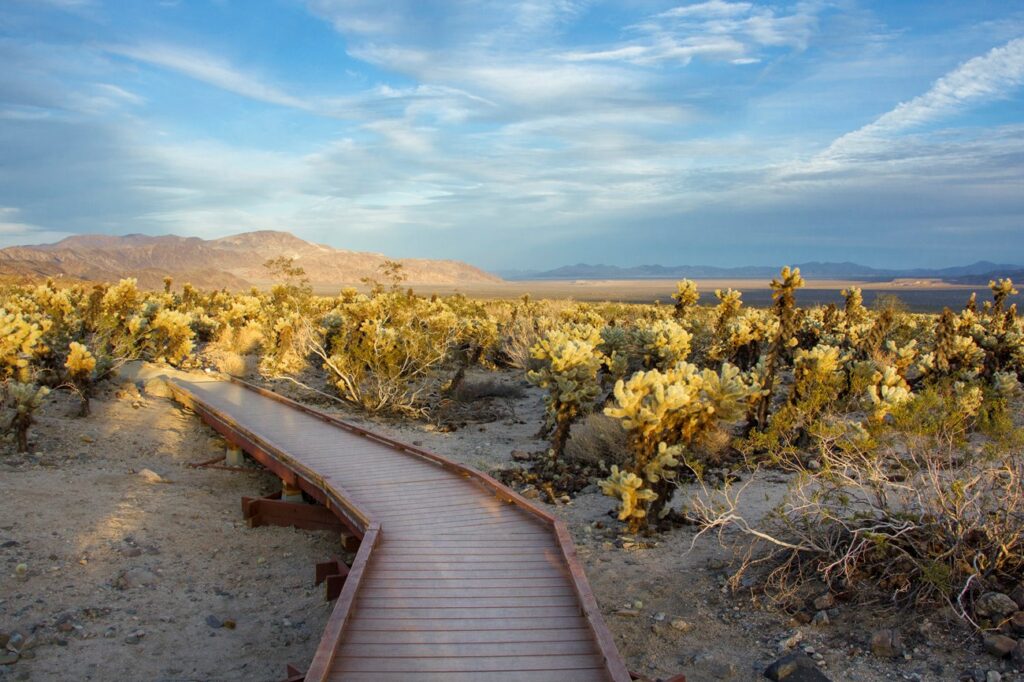
Cholla Cactus Garden
The day begins at Cholla Cactus Garden, one of the best places to start your one-day journey. Entering from Twentynine Palms, a quieter route than Joshua Tree town, you’ll experience the magical morning light casting a golden glow over the cacti. Walk along the trail, admire the variety of shapes and sizes, and be mindful of the sharp spikes, which are painful to extract. There is a car park immediately in front, making it an easy stop before you drive to Arch Rock, which takes about 15 minutes.
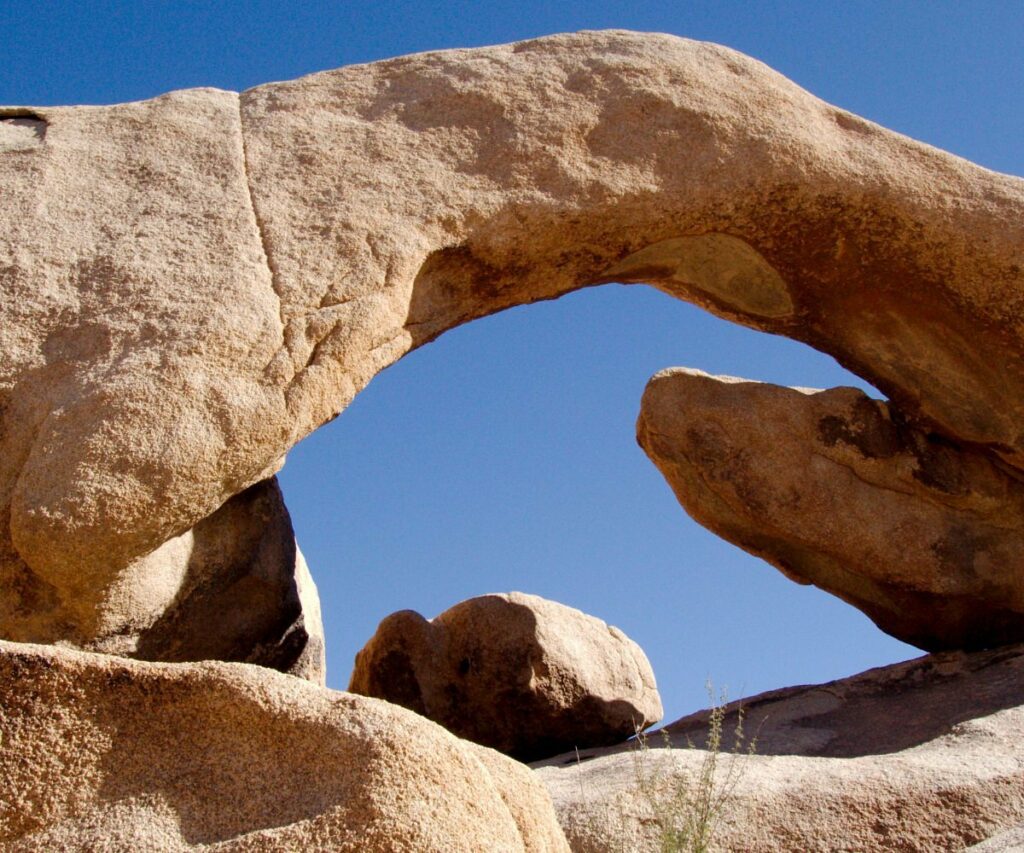
Arch Rock
At Arch Rock, gaze at the blue sky and take in the iconic natural formation, one of the most photographed spots in the park. The small crowd gathered here speaks to its popularity. You can climb and scramble around the cool slots and scenic views.
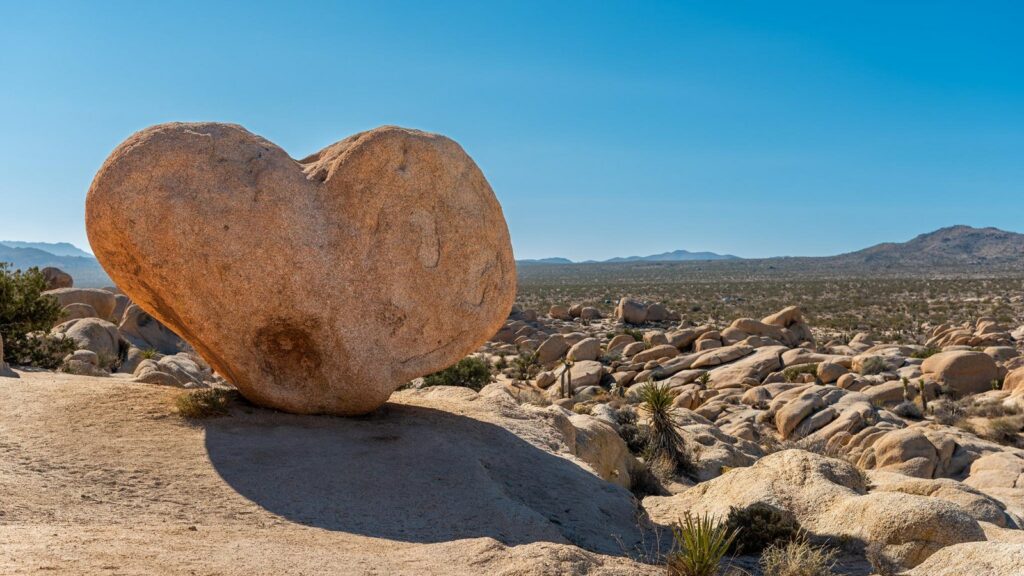
Heart Rock
If you have time, take a short detour to Heart Rock, located a short distance away. The direction is marked by a sign, and the Nature Trail is an easy 1.1 miles (1.9 km) out-and-back. My smartwatch calculated the distance as 3.12 km, including the detour.

Skull Rocks & Jumbo Rocks
Next, drive to Skull Rock—a 10-minute ride.
Stopping at Skull Rock & Jumbo Rocks, you’ll witness a skull-shaped formation shaped by millions of years of erosion. It’s a famous photo opportunity, though some people struggle to identify the exact formation. The Discovery Trail here loops through the campground, offering great spots to scramble and learn fun facts from the signboards. In March, outside holiday periods, parking isn’t an issue, but it gets crowded during peak times.

Hidden Valley
From here, it’s a 15-minute drive to Hidden Valley.
The Hidden Valley Nature Trail is another breathtaking stop, known for its rock formations, small leafy patches, and incredible scenery. It’s suitable for all visitors without accessibility requirements and is the ideal length at 1 mile (1.6 km), although my tracker showed closer to 2 km due to extra walking. Arriving by 9:00 AM, the parking lot was still empty, but by 10:00 AM, it was full. There are toilets (outhouses) but no running water, so bring hand sanitizer. After exploring,

Hall Of Horrors
continue to Hall of Horrors, just 7 minutes away.
At Hall of Horrors, you’ll find towering rock formations and eerie slot canyons. From the top, you get a stunning view of the scattered Joshua Trees. The photographs taken here are unforgettable. If you walk to the left, you’ll discover another hidden slot, perfect for those who love a bit of climbing. The crows circling overhead add a spooky feeling.
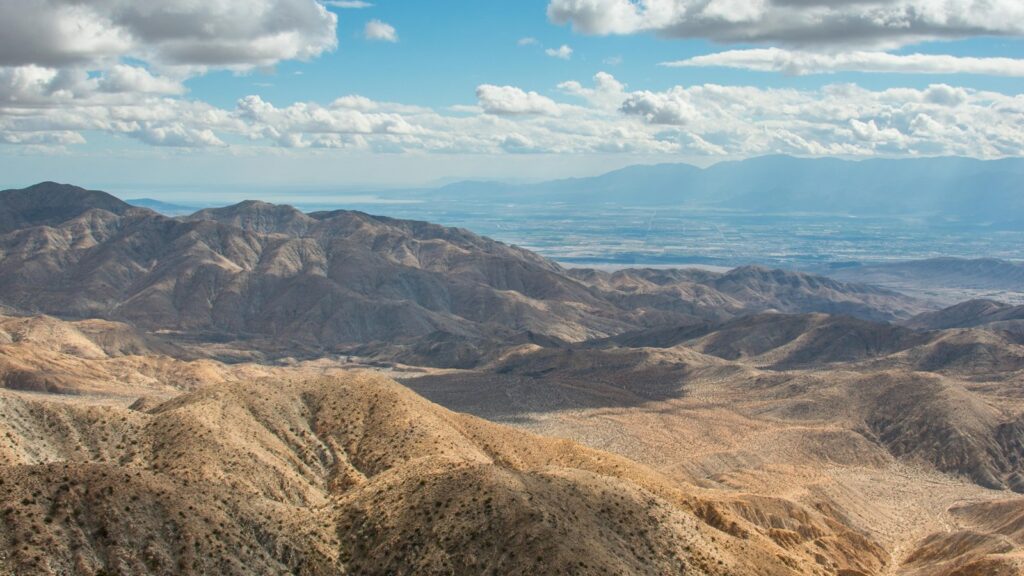
Keys View
Next, continue on a 12-minute drive to Keys View.
Arriving at Keys View during golden hour or sunset is one of the most special moments of the trip. The mountain range, the blue and orange clouds, and the sweeping views of Coachella Valley make it a panoramic viewpoint worth visiting. On a clear day, you can even spot the San Andreas Fault and, in the distance, Mexico’s peaks. If you have extra time, check out Inspiration Peak nearby. Make sure to grab a spot early before it fills up. When leaving, take a 10-minute drive to Cap Rock.
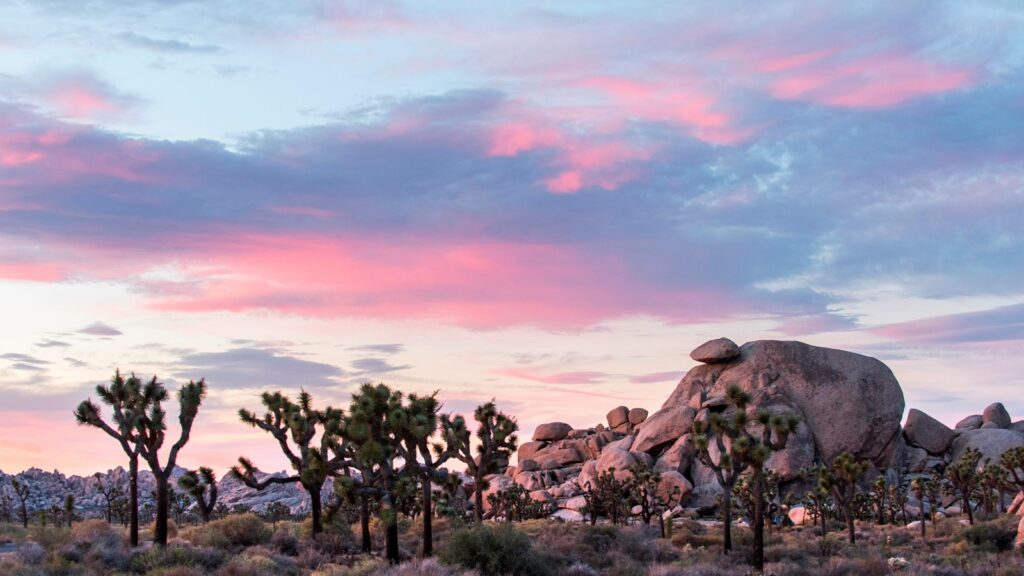
Cap Rock
Cap Rock, a fascinating desert formation, is a tall rock with another balanced precariously on top. It’s a great place for photographs and one of my favourite stops of the trip. While you can climb the boulder, the best way to experience it is by standing on the ground and taking in the opposite field, where a cluster of Joshua Trees creates a mesmerizing landscape. After this, take a 40-minute drive to Pioneertown.
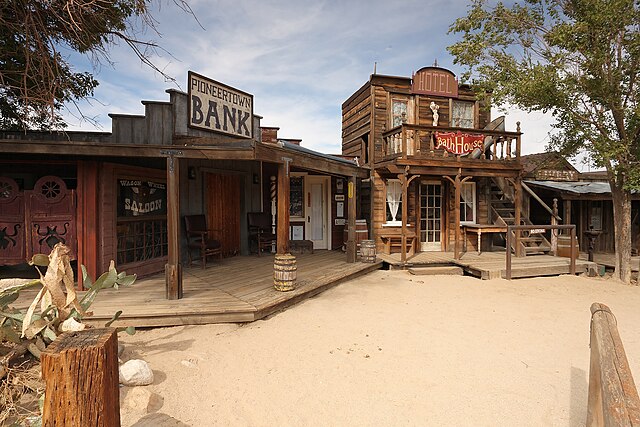
Pioneertown
Pioneertown is a fun stop before heading back toward Palm Springs or Los Angeles. This old Western-style town is known for its General Store, unique shops with clothing racks, and the iconic Pappy & Harriet’s, a lively venue with live performances. If you’re visiting between Thursday and Monday, you can grab dinner here and enjoy the musical entertainment. For a more relaxed atmosphere, check out Red Dog Saloon for food and drinks.
More Stops to Consider in Your Itinerary
If you have extra time in Joshua Tree National Park, there are a few additional stops to include:
Ryan Mountain – A 3-mile round trip hike offering panoramic 360-degree views and possible sightings of Bighorn Sheep. The trail has a 1,000-foot elevation gain, making it a short but intense climb.
Face Rock – A hidden gem, found on the Discovery Trail near Skull Rock. The flat, sandy junction makes it an easy spot to reach, though many people walk past it without realizing its unique shape.
Split Rock – A well-marked area with a parking and picnic area. It connects to Face Rock Trail, making it an excellent spot for more exploration.
Arch Rock – One of the most iconic formations, located on Pinto Basin Road near White Tank Campground. The Nature Trail is an easy half-mile loop, but the plaque marking the arch is easy to miss if you’re not paying attention.
Heart Rock – A hidden treasure, located off-trail near Arch Rock. There’s no road map, but if you look toward the mountains, you might be able to spot it.
Cholla Cactus Garden – A well-maintained maze of Cholla Cacti, known for their sharp spikes that can cause painful injuries if touched. A great stop for seeing diverse vegetation beyond the usual Joshua Trees.
Ocotillo Patch – Found further down Pinto Basin Road, this area showcases the spindly Ocotillo plants, which become more prevalent as you transition into the Colorado Desert.
At the end of the day, you can complete the loop by exiting through the North Entrance or backtrack to the West Entrance to return the way you came. Either way, this wraps up an incredible one-day Joshua Tree itinerary!
you don’t know what to do if you have 7 days in Belize checkout our detailed guide here
How Long Do You Need in Joshua Tree National Park?
If you have limited time, it is possible to create a one-day itinerary that covers the main sights in Joshua Tree. However, I strongly recommend spending the night in the area to make the most of your visit. Arriving early allows you to experience the beauty of sunset, while staying late lets you watch the sunset over the stunning desert landscape.
The ideal amount of time to see most of Joshua Tree National Park’s best sights and explore its surrounding areas, including Pioneertown, local shops, and restaurants, is three days. This is why I highly recommend check out a weekend guide, which helps visitors plan their stay and discover the true essence of Joshua Tree beyond a single day.
If you decide to spend the night, I suggest booking a stay at Holiday Inn Express Twentynine Palms for its convenient access to the park. Alternatively, you can choose from vacation rentals such as a one-bedroom cabin with a pool on the border of JTNP, a large and stylish home with a mountain view and hot tub, or a 2-bedroom Moroccan-themed bungalow located in 29 Palms town.
Can You Visit Joshua Tree in One Day?
Yes, you can visit Joshua Tree National Park in one day, but you will need to move quickly and follow a logical order to make the most of your time. While you cannot see everything in the park, you can still see many highlights in one day, making it a worthwhile trip.
What Not to Miss in Joshua Tree National Park?
When visiting Joshua Tree, make sure to include key locations such as Cholla Cactus Garden, Arch Rock, Skull Rock, Jumbo Rocks, and Hidden Valley Nature Trail in your trip. These spots showcase the park’s most stunning landscapes. Also, don’t forget to stop, enjoy, and photograph the Joshua Trees throughout the park—Cap Rock offers a convenient car park for this.
What Is the Most Scenic Part of Joshua Tree National Park?
One of the most scenic routes in Joshua Tree National Park is the drive along Park Boulevard, stretching from Cap Rock to Skull Rock. This area is filled with a large number of Joshua Trees, making it a breathtaking sight. For those interested in unique landscapes, Arch Rock is one of the most impressive rock formations in the entire park and is a must-see.
Know Before You Go
Before visiting Joshua Tree National Park, make sure to follow the Leave No Trace Principles to help preserve the park’s natural beauty so it can be enjoyed for years to come. Staying on marked paths, carrying out trash, and respecting wildlife will help keep the area pristine for future visitors.
It’s important to check the official Joshua Tree NPS website prior to your visit for the most up-to-date park, road, and trail conditions. Some roads and hiking paths may be temporarily closed due to weather or maintenance, so always stay informed before heading out.
The park is home to a wide array of plants and cacti, including cholla cactus. These cholla barbs can be painful and difficult to remove, so always stay on designated paths to avoid accidental contact. Also, trails have minimal shade, so come prepared for your Joshua Tree hike with plenty of water, sun protection, and sturdy shoes.
Expect minimal cell service in Joshua Tree National Park, so be equipped with a GPS-enabled device. I recommend pre-downloading maps for offline use on the Gaia GPS app for iPhone and Android devices. You can download it at GaiaGPS.com and get 10% off. Also, keep in mind that there are no amenities in the park, meaning no food, water, or gas stations, so plan ahead. If you’re looking for places to eat near Joshua Tree.
More Than One Day in Joshua Tree: Things to Do
If you have more than one day in Joshua Tree, there are plenty of ways to stay busy and explore beyond a basic itinerary. While the personal favorite spots in a one-day trip are great, you may want to replace some stops with other attractions that offer deeper insight into the park’s history and landscapes.
For history lovers, Joshua Tree’s mining history is fascinating. The park has several areas where you can get a glimpse of its past through short hikes or guided ranger walks. You can visit Barker Dam, a 1.1-mile trail showcasing a historic water tank built by an early cattle rancher. Other historic spots include Keys Ranch, offering restricted 90-minute tours to preserve the story of William F. Keys, Ryan Ranch, a 1-mile hike to an old adobe structure, and Lost Horse Mine, a 4-mile moderate hike leading to a gold mine.
Visit a Desert Oasis
If you want a different side of the park, visit a Desert Oasis. Joshua Tree has several areas where you can find an oasis of fan palms and Cottonwood Trees, giving hikers a chance to see diverse vegetation and find some shade relief from the sun. The Oasis of Mara is an easy half-mile trail near the Oasis Visitor Center, while Cottonwood Springs is a ten-minute walk through a fan palm oasis near the Cottonwood Visitor Center. If you want a longer trek, try Fortynine Palms Oasis, a 3-mile out-and-back hike, or Lost Palms, a half-day trek that takes you through washes, canyons, and a remote oasis.
Take a backcountry drive
For off-road enthusiasts, a backcountry drive along Geology Tour Road is a must. This 18-mile scenic drive through Joshua Tree National Park winds through dramatic landscapes and has informational stops along the way. The dirt road gets rough after a few miles, so a 4×4 is recommended.
Camp in the backcountry
If you prefer solitude, try backcountry camping. Backpacking in Joshua Tree is rare due to the limited long trail system, so you’ll likely find peace and quiet. Permits are required but free and simple to get—just register at the trailhead before beginning your hike.
are you planning you 4 days trip to boston? checkout our comprehensive guide what to do and how to spend 4 days in boston.
Best Time of Year to Visit Joshua Tree National Park
The best time to visit Joshua Tree is between October and May when day temperatures are tolerable in the 80s, and nights are comfortably cool in the 50s. Spring is a great season to visit because it has the least amount of rain, although it doesn’t really rain often here at any time of the year.
In winter, the day temperatures are still nice for hiking and exploring, but the nights can drop below freezing. If you plan to stay overnight, pack warm layers to stay comfortable in the cold desert air.
You probably should not visit Joshua Tree in summer because it is often too hot to enjoy the park fully. With temperatures reaching triple digits, the best way to see the scenery is from an air-conditioned car. However, this makes your time in the park quick, and you’ll miss out on cool hikes. Some campgrounds and facilities may also be closed. If you do come in summer, avoid strenuous activities and keep outdoor adventures for the morning or evening to avoid the midday heat.
Where to Stay in Joshua Tree National Park
If you plan to spend one day in Joshua Tree, arriving the night beforehand can help you get up early and make the most of your time. This way, you’ll be near all the best things to do and have a chance to enjoy the incredible International Dark Sky Park, where you can see the Milky Way like never before. If you love stargazing, I highly recommend spending the night here.
There is no lodging or hotels inside Joshua Tree, apart from camping. However, you can stay in nearby areas like Yucca Valley or Palm Springs, where you’ll find good options for Airbnbs and hotels. These locations provide easy access to the park while offering more amenities than camping.
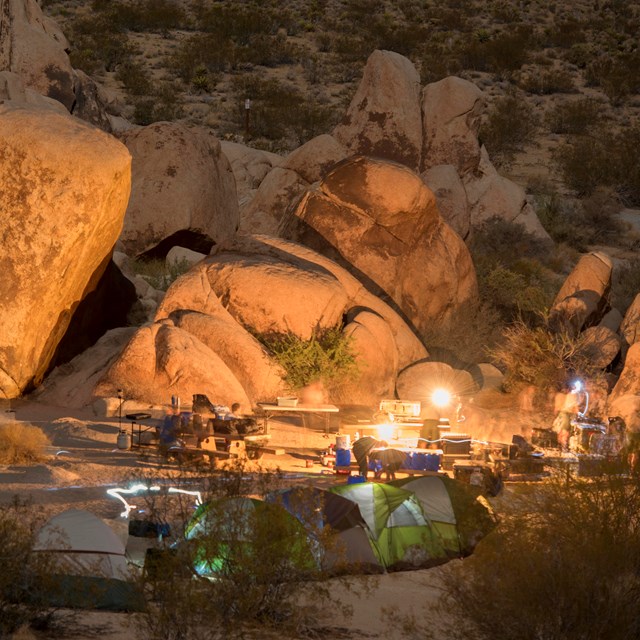
Camping in Joshua Tree National Park
For those who enjoy camping in Joshua Tree National Park, there are 8 campgrounds and one group camping site. Some of the most popular campgrounds require reservations, including Black Rock, Cottonwood, Indian Cove, Jumbo Rocks, and Ryan. Many of these sites are primitive, with only a pit toilet and no drinkable water, so be sure to book early and bring plenty of supplies. Prices range from $20 to $25 per night.
If you don’t have a reservation, you can try one of the first-come, first-served campgrounds: Hidden Valley, White Tank, and Belle. These cost $15 per night, but there is no self-registration system—a ranger will collect payment during the day. Keep in mind that weekends, holidays, and peak months like Spring (February to May) can make it difficult to find an available campsite. I visited in early November on a Sunday and couldn’t find a spot, so I highly recommend booking in advance.
Free camping near Joshua Tree
If there’s no space inside the park, you can check private RV sites and campgrounds outside Joshua Tree National Park. Alternatively, free camping near Joshua Tree is available on BLM land at the north and south edges of the park. This option is completely primitive, meaning there are no restrooms, water, or facilities, so you must pack in everything you need and pack out all trash.
The northern area of BLM land is popular but noisy, so bring earplugs if you plan to sleep early. The roads are rough with potholes, so drive carefully, especially at night. I suggest arriving while it’s still light out to find a good spot. The southern area has larger, well-defined camping sites, is less crowded, and offers a quieter, more enjoyable experience.
Tips for Visiting Joshua Tree National Park in One Day
Before heading out, make sure to purchase a Joshua Tree park pass, which costs $30 per vehicle and lasts for 7 consecutive days. You can buy it online before your trip or get one in person at the park entrances. This will save you time and ensure a smooth entry into the park.
No matter the time of year you visit Joshua Tree, bring plenty of water to stay hydrated. The hot and dry conditions can be exhausting, especially if you’re hiking. The only places to fill up drinking water are at the visitor centers and park entrances, so plan ahead. Also, sun protection is a must—wear sunscreen, a hat, sunglasses, and long-sleeve clothes to protect yourself from the strong desert sun.
If you plan to hike in the rugged, rocky landscape, wear sturdy hiking shoes or boots to prevent injuries like a rolled ankle or sore feet. If you’re spending the night or staying to stargaze, bring layers since the desert can get chilly at night. Also, timing your hikes is important—start bigger hikes early in the morning or later in the evening to avoid the midday heat, especially in hotter months like summer.
If you don’t have a campsite booked, have a backup plan for the night. Last-minute camping sites may not be available, so be prepared to pay extra cash for a private campsite outside the park or stay at a primitive camping site. Since there are no restaurants or stores in the park, bring plenty of snacks and food. Cell service is limited, so download maps, reservations, and passes before you go. Finally, be respectful of the vegetation, especially the Joshua Trees, as they are highly fragile—do not touch, climb, or attach ropes for hammocks. Always follow Leave No Trace principles by packing out everything you bring in.
Read: how to spend 24 hours in venice
Conclusion: One Day in Joshua Tree National Park
Joshua Tree National Park is a place with a unique landscape that will leave you in awe. Even though it is possible to experience the highlights in a day, I highly recommend taking time and spending a few days in the area if you can. A carefully planned itinerary can help you make the most of your trip, but exploring at a slower pace allows you to appreciate the park’s beauty even more.
A one-day visit gives you a taste of what Joshua Tree has to offer, but dedicating more time will give you the opportunity to see diverse landscapes, take longer hikes, and witness an unforgettable sunrise or sunset. If you want a more immersive experience, staying overnight will make your trip even more special.
Planning is essential to making the most of your time in Joshua Tree. Be sure to start early to beat the crowds and the heat. A solid plan will ensure you visit all the key spots and enjoy your adventure without feeling rushed.
Thanks for joining this one-day adventure in Joshua Tree National Park! I hope this itinerary inspires your next trip and helps you discover the magic of this incredible place. If you want to explore further, check out my detailed itineraries, including the comprehensive Joshua Tree 2-3 Day Itinerary & Travel Guide, which is part of my brand-new shop page. Each month, I will be adding in-depth guides for national parks and road trip-worthy regions to help you plan your upcoming adventures.
I hope you find adventure and encouragement wherever you go! If you have questions or want to share a favorite spot that wasn’t included, feel free to leave a comment!

